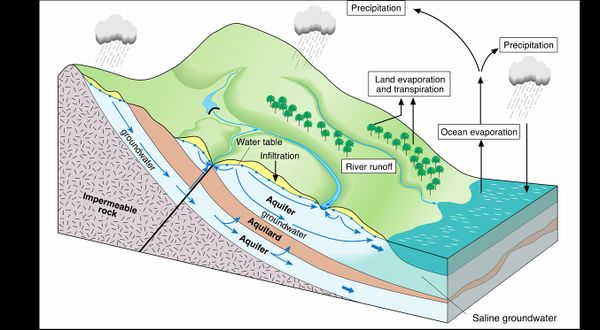Knowledge fuels change
For over a decade, Energypedia has shared free, reliable energy expertise with the world.
We’re now facing a serious funding gap.
Help keep this platform alive — your donation, big or small, truly matters!
Thank you for your support
Difference between revisions of "SPIS Toolbox - Understanding Groundwater"
***** (***** | *****) |
***** (***** | *****) m |
||
| Line 1: | Line 1: | ||
| − | |||
== UNDERSTANDING GROUNDWATER == | == UNDERSTANDING GROUNDWATER == | ||
| Line 8: | Line 7: | ||
Groundwater is naturally recharged by precipitation or by infiltration from rivers and lakes. The underground water movement from areas of recharge to areas of aquifer discharge through springs and seepage to rivers, lakes, wetlands and coastal zones is called groundwater flow. The natural flow of groundwater occurs, generally at low velocities, through pore spaces and fractures in rock materials. Depending on the aquifer geological composition, water flow velocity varies from 1 meter per day to 1 meter per year or per decade. In contrast, velocities of river flow are much faster and expressed in meter per second. Groundwater levels may vary seasonally and annually. They are then high after the wet season and low at the end of the dry season. | Groundwater is naturally recharged by precipitation or by infiltration from rivers and lakes. The underground water movement from areas of recharge to areas of aquifer discharge through springs and seepage to rivers, lakes, wetlands and coastal zones is called groundwater flow. The natural flow of groundwater occurs, generally at low velocities, through pore spaces and fractures in rock materials. Depending on the aquifer geological composition, water flow velocity varies from 1 meter per day to 1 meter per year or per decade. In contrast, velocities of river flow are much faster and expressed in meter per second. Groundwater levels may vary seasonally and annually. They are then high after the wet season and low at the end of the dry season. | ||
| − | [[File:HydroCicle. | + | [[File:HydroCicle.jpg|thumb|center|600px|The Hydrologic Cycle.]] |
<br/> | <br/> | ||
Revision as of 08:23, 19 May 2017
UNDERSTANDING GROUNDWATER
Groundwater within the hydrogeological cycle
SPIS is based on the abstraction of groundwater from open wells or tube wells. Therefore, it is necessary to understand groundwater systems to manage groundwater in a sustainable manner. Groundwater is the water found underground in the cracks and pores in soil, sand and rock, called aquifer. Aquifers store high amounts of groundwater and are therefore an important reservoir and buffer within the hydrologic cycle (see figure).
Groundwater is naturally recharged by precipitation or by infiltration from rivers and lakes. The underground water movement from areas of recharge to areas of aquifer discharge through springs and seepage to rivers, lakes, wetlands and coastal zones is called groundwater flow. The natural flow of groundwater occurs, generally at low velocities, through pore spaces and fractures in rock materials. Depending on the aquifer geological composition, water flow velocity varies from 1 meter per day to 1 meter per year or per decade. In contrast, velocities of river flow are much faster and expressed in meter per second. Groundwater levels may vary seasonally and annually. They are then high after the wet season and low at the end of the dry season.
Groundwater balance
Under natural conditions, groundwater storage within the aquifer is in balance. It recharges in wet seasons and provides water for the base flow of rivers, lakes and wetland throughout the year. This balance can be disturbed by human interventions that may affect both the amounts of recharge and discharge.
Important agricultural activities with effects on the groundwater balance
| Recharge |




















